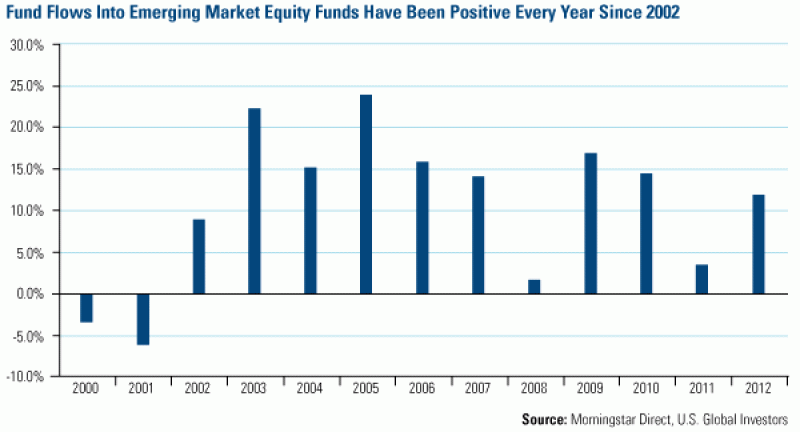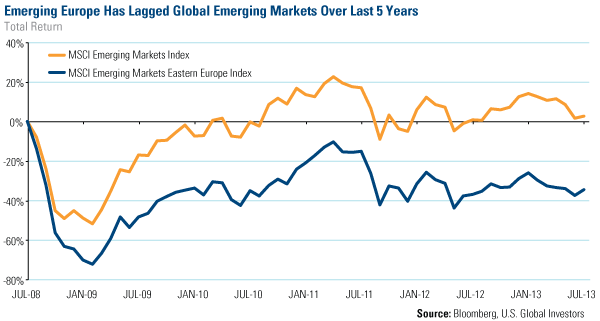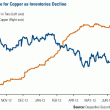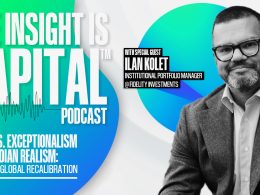Emerging Markets Radar (August 19, 2013)
Strengths
- In the first seven months of 2013, net flows into emerging market funds were positive at $21.8 billion, according to Morningstar. Since 2002, flows into emerging market funds have been positive every year, including 2008 and 2011. More importantly, actively managed emerging market stock funds have seen positive net flows every month in 2013. This suggests that the trend driving these flows has been a wholesale shift towards permanent allocations to the asset class, and not solely based on performance chasing. Furthermore, emerging market stock funds have come a long way in the past ten years, evolving from a 1 percent holding, to a core holding in many investors' portfolios.
- Eurostat, the European Union’s statistics office, announced that the seventeen countries that use the euro as currency grew their gross domestic product (GDP) by 0.3 percent during the second quarter of 2013. This reading marks the first quarterly growth since 2011, thus ending the six-quarter recession. Eastern Europe is set to benefit from growth throughout the euro area, its main trading partner, as it seeks to reignite its own growth. Within this region, the Czech Republic’s GDP rose 0.7 percent in the second quarter, while Poland, the European Union’s largest eastern economy, expanded 0.8 percent from a year earlier.
- Chinese media reported that local governments are initiating a new round of urban rail construction, with approved project investment amounting to Rmb 4 trillion by 2020. The operating mileage of China’s urban rail transit systems will increase by 6,000 kilometers in 2013 and reach more than 8,000 kilometers by the end of 2020. After the National Development and Reform Commission (NDRC) delegated the administration of urban rail projects to provincial authorities in May 2013, local governments have been showing strong motivation to accelerate approvals, with a total of fourteen projects given the “green light” year-to-date. Also in the news, the Agriculture Bank of China lent Rmb 250 billion to the Shanghai municipal government. The market believes that the mainland government is quietly offering financial stimulus to key cities to help them maintain local economic growth.
- The People’s Bank of China (PBOC), the central bank, continued reverse repo operations for Rmb 11 billion this week, which indicates that the government is facilitating liquidity needs for the banks.
- The Hang Seng Index crossed the 200-day moving average this week, driven by cyclical stocks and after Premier Li Keqiang showed policy support for a 7.5 percent GDP growth floor this year and a 7 percent growth floor for the foreseeable future, with targeted stimulus in chosen industrial sectors such as environmental protection, information technology, and urban and railway infrastructures.
- China Merchants Bank announced a rights offer to raise HK$35 billion last Friday, which indicates that the Chinese government has realized a need to strengthen the banks’ balance sheet. Although dilutive, more banks will be allowed to raise funds to replenish tier-one capital.
- The manufacturing sector in the Philippines grew slower in June at 9.9 percent, and 13.5 percent for the second quarter. Net sales index expanded by 22.2 percent in June and 21.5 percent for the second quarter, which suggests a lower risk of inventory overhang amid a strong output signal.
Weaknesses
- Russia’s industrial production fell more than anticipated in July, while manufacturing contracted for a third consecutive month, stressing the severity of the country’s economic slowdown. Industrial output shrank 0.7 percent from a year earlier, compared to the forecast of a 0.2 percent decline. Industry accounts for about a quarter of gross GDP, increasing the concern about the economy growing less than the official forecast of 2.4 percent.
- Once again, economists lowered their 2013 and 2014 growth forecasts for Brazil as the government struggles to revive expansion in the world’s second-largest emerging economy. New estimates signal that GDP will expand 2.21 percent this year and 2.5 percent next year.
- Bank Indonesia (BI) left the policy rate unchanged at 6.5 percent, which is in line with the consensus. Nevertheless, BI is introducing measures to reduce excessive liquidity to contain inflationary pressures. These measures include a higher secondary reserve requirement of 4 percent from 2.5 percent, stricter loan-to-deposit ratios reduced to 92 percent from 100 percent; and the issue of BI deposit certificates within the next few months.
- Singapore’s retail sales declined 4 percent in June, versus the consensus of a 2.5 percent gain, as car sales plunged.
- On the front page commentary in China Securities Journal, reporter Ren Xiao wrote that it is still too early to conclude whether China’s economy will rebound after recently announcing its stimulus measures.
Opportunities
- It is evident in the chart below that emerging markets were quick to recover from the 2008 financial crisis, even without a significant rise in Chinese stocks. The story for Eastern Europe has been radically different. Countries like Poland and the Czech Republic have been dragged down into periods of recession due to their export dependence on Western Europe, while Russia has continued to struggle in a weak commodity-price environment. This “guilt by association” is set to change now that recent macroeconomic indicators have turned positive and Europe appears to be on its path to sustainable growth. Eastern Europe could benefit handsomely from a European recovery and is set to close the five-year gap with global emerging markets.
- A key point to take from the tax reform that is in place in Colombia as of this year, is that the payroll taxes and other non-wage costs paid by the companies decreased from around 29.5 percent to 16 percent. Francisco Schumacher, Andean Strategist at HSBC, believes this is likely to accelerate formalization and job creation in Colombia, which has one of the highest urban unemployment rates in the continent at 11.2 percent. Companies with a high number of employees should see a relief in their labor costs from this tax reform.
- As shown in the graph above, mobile internet users grew at a double-digit speed in the first half of this year alone, which has driven an e-commerce boom in China. Most profitable from mobile internet users is online games, followed by advertising and online shopping. It is predicted that online shopping companies will be making profits next year as more and more people conduct shopping through smart phones.
Threats
- Turkey’s current account deficit is the eastern economy’s biggest area of vulnerability, even as it reduced the shortfall to about 6 percent of GDP last year, from 10 percent in 2011. The consensus is that the current account deficit will likely be lower than the initial market consensus of $55 billion to $60 billion, however, it will still be very high nominally and difficult to finance. On the news front, the most recent reading shows the nation’s current account deficit narrowed to a seven-month low in June. The news coincided with a sharp increase in output in the services industry, demonstrating the headwinds are short term and that the European nation is on its path to recovery.
- Argentine President Cristina Fernandez de Kirchner continues to accelerate fiscal spending in order to boost her party’s chances in the October elections. She pushed the fiscal deficit closer to the 2001 default level and drained foreign reserves that are plummeting at the fastest rate within a decade. The fiscal shortfall widened by 40 percent in the first five months of this year, prompting Fernandez to draw billions of reserves to make foreign debt payments. The government is partly unable and partly unwilling to issue debt, leaving the only alternative as the monetization of its deficit through reserves, which fuels inflation.
- China’s NDRC launched sector-wide investigations in the healthcare industry, continuing bribery crackdowns after finding sales misconduct of GlaxoSmithKline in China. Although it is a short-term event, market sentiment was affected with the news.


















